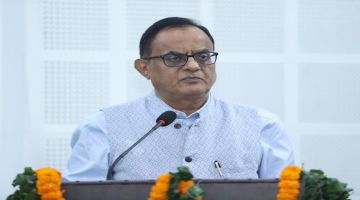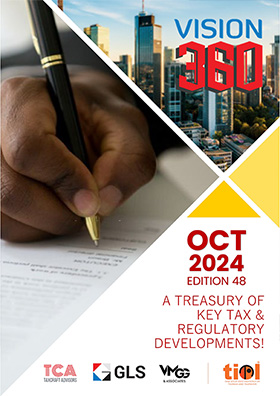Indian economy continues to consolidate gains in current fiscal; CAD down to 1.1% of GDP & forex kitty quite comfortable: Jaitley
By TIOL News Service
 |
NEW DELHI, JAN 01, 2017: DURING the current Financial Year 2016-17, the Indian Economy has continued to consolidate the gains achieved in restoring macro-economic stability. Despite the continuing global sluggishness and recent pick-up in petroleum prices, the economic growth has continued to be robust and inflation has remained more or less stable in the current year, while Fiscal Deficit and Current Account Deficit as percentage of GDP have improved. The Growth Rate of the economy during the First Half of the current Financial Year is estimated at 7.2 per cent, which makes India one of the fastest growing major economies in the world. At the sectoral level, the growth rates for agriculture & allied sectors, industry and services sectors for the First Half of the current year are estimated at 2.5 per cent, 5.6 per cent, and 9.2 per cent respectively. The stress given to fiscal consolidation through expenditure rationalization and revenue raising efforts and the focus on administrative measures for cooperative financial governance and also steps towards containing inflation have contributed significantly to macro-economic stability.
Inflation
Inflation measured in terms of Consumer Price Index and Wholesale Price Index has remained in comfort zone during the current Financial Year 2016-17. CPI (Combined) inflation for 2015-16 declined to 4.9 per cent from 5.9 per cent in 2014-15. It averaged 5.2 per cent in 2016-17 (Apr-Oct) and stood at 4.2 per cent in October 2016. Food inflation as measured by Consumer Food Price Index (CFPI) declined to 4.9 per cent in 2015-16 from 6.4 per cent in 2014-15. It averaged 6.1 per cent in 2016-17 (Apr-Oct) and eased to 3.3 per cent in October 2016.WPI inflation declined to (-) 2.5 per cent in 2015-16 from 2.0 per cent in 2014-15. It averaged 2.7 per cent in 2016-17 (Apr-Oct) and stood at 3.4 per cent in October 2016.
As per the revised Monetary Policy Framework, the Government has fixed the inflation target of 4 per cent with tolerance level of +/- 2 per cent for the period beginning from August 5, 2016 to March 31, 2021. The Government monitors the price situation on a regular basis as controlling inflation is a key priority and has taken a number of measures to control inflation especially food inflation. The steps taken, inter alia, include, (i) increased allocation of Rs. 900 crore for Price Stabilization Fund in the budget 2016-17 to check volatility of prices of essential commodities, in particular of pulses; (ii) created buffer stock of pulses through domestic procurement and imports; (iii) announced higher Minimum Support Prices so as to incentivize production; (iv) issued advisory to States/UTs to take strict action against hoarding and black marketing under the Essential Commodities Act 1955 and the Prevention of Black-marketing and Maintenance of Supplies of Essential Commodities Act, 1980.
Trade
India's merchandise exports (customs basis) declined by 15.5 per cent to USD 262.3 billion in 2015-16. In 2016-17 (April-October), growth of exports declined by 0.2 per cent (USD 154.9 billion vis-à-vis USD 155.2 billion in the corresponding period of previous year). Imports declined by 15.0 per cent to USD 381.0 billion in 2015-16. Imports for 2016-17 (April-October) were at USD 208.1 billion which is lower by 10.9 per cent as compared to USD 233.4 billion in the corresponding period of previous year. During 2016-17 (April-October), trade deficit decreased to USD 53.2 billion as against USD 78.2 billion in the corresponding period of previous year. There has been significant market diversification in India's trade from Europe and America to Asia and Africa in recent years –a process that has helped in coping up with the sluggish global demand.
Balance of Payments
Current Account Deficit (CAD) narrowed down to USD 22.2 billion (1.1 per cent of GDP) in 2015-16 as compared to USD 26.9 billion in 2014-15. CAD narrowed down to USD 0.3 billion (0.1 per cent of GDP) in 2016-17 (April-June) from USD 6.1 billion (1.2 per cent of GDP) in corresponding period of the previous year.
Foreign Exchange Reserves
In the current fiscal 2016-17, foreign exchange reserves culminated to USD 372.0 billion at end September 2016 which reduced to USD 366.2 billion at end October 2016. Foreign exchange reserves stood at USD 365.3 billion on 25th November 2016, showing an increase of USD 5.1 billion over the level of USD 360.2 billion at end-March 2016. Country's foreign exchange reserves are at a comfortable position to buffer any external shocks. In the current fiscal 2016-17 (April-November), the average monthly exchange rate of rupee (RBI's reference rate) was in the range of Rs. 66 – 67 per US dollar (Rs. 66.47 per US dollar in April 2016 and Rs. 67.80 per US dollar in November 2016).
External Debt
India's external debt stock stood at USD 479.7 billion at end-June 2016, witnessing a decline of USD 5.4 billion (1.1 per cent) over the level at end-March 2016. The external debt-GDP ratio was 23.4 per cent at end-June 2016, as against 23.7 per cent at end March 2016. The share of long-term external debt in total external debt increased marginally to 82.9 per cent at end-June 2016 from 82.8 per cent at end-March 2016. All external debt indicators show that India's external debt has remained within manageable limits. India continues to be among the less vulnerable nations in terms of its key debt indicators.
Agriculture and Food Management
Agriculture and allied sectors registered a growth of 2.5 per cent during the first half of 2016-17 as compared to 2.3 percent during the same period in 2015-16. As per the First Advance estimates (1 st AE) 2016-17 released by Department of Economics and Statistics, production of Kharif food grains is estimated to increase to 135.03 million tonnes as compared to 124.01 million tonnes in 2015-16 (AE).
The report of the Committee on "Incentivising Pulses Production through Minimum Support Price (MSP) and Related Policies" set up under the Chairmanship of Dr. Arvind Subramanian, Chief Economic Adviser, Government of India was submitted on 16th September, 2016. The Committee has recommended, among other things, an increase in the minimum support price (MSP) for all pulses, elimination of the export ban and stock limits on pulses, and intensified procurement.
Industry
The data on Index of Industrial Production (IIP) released by the Central Statistical Office (CSO) shows that the production of industrial sector broadly comprising mining, manufacturing and electricity sectors has fallen by 0.3 per cent during April-October (2016-17) as compared to 4.8 per cent growth during April-October (2015-16). The Government has undertaken a number of policy measures including enhanced public investment, kick starting stalled projects, improving governance through systemic changes like open auction for natural resources like coal and spectrum, improving business environment through programmes like Make in India, Ease of Doing Business, Start-up India. The Government has also liberalized and simplified the foreign direct investment (FDI) policy in the sectors like defence, railway infrastructure, construction and pharmaceuticals etc.















